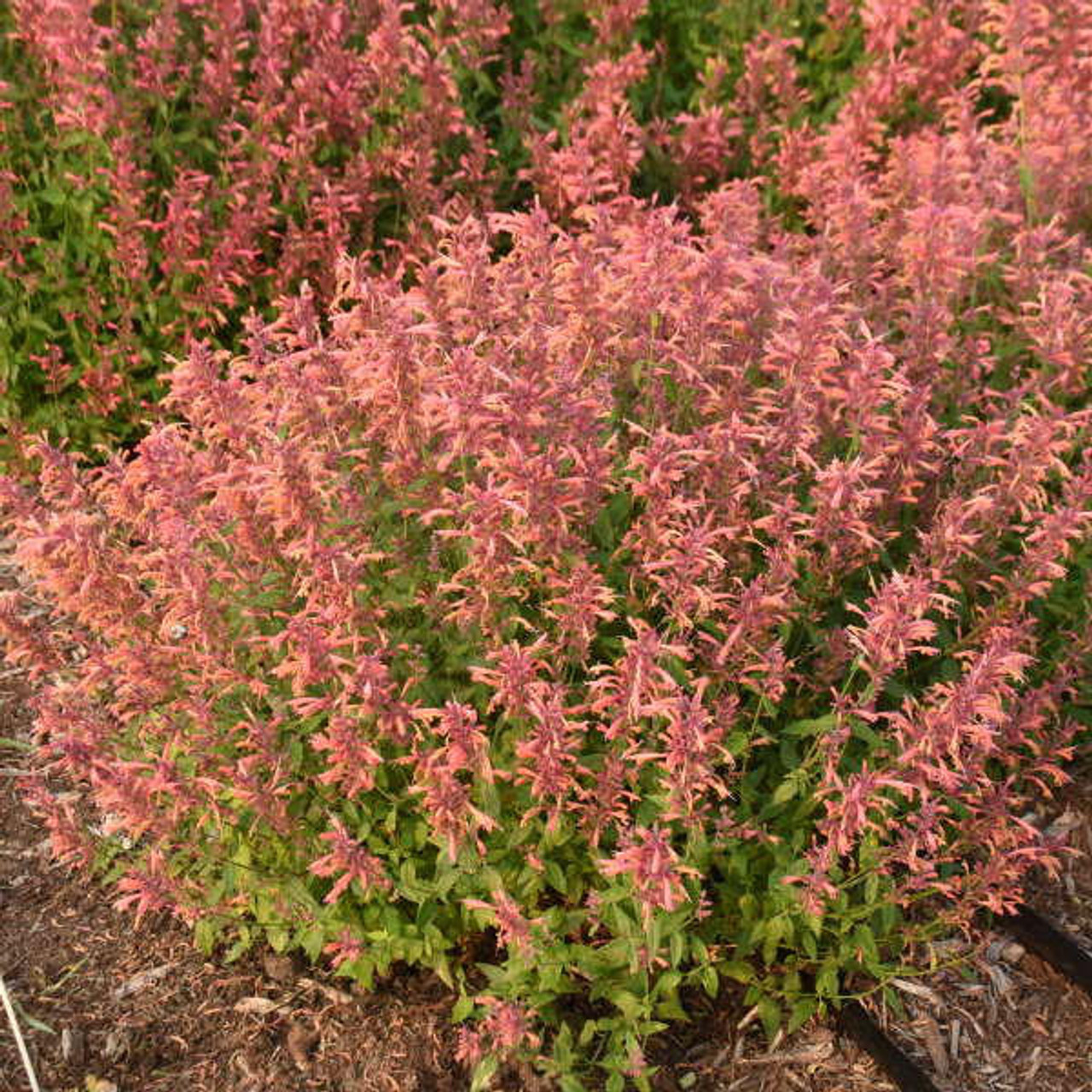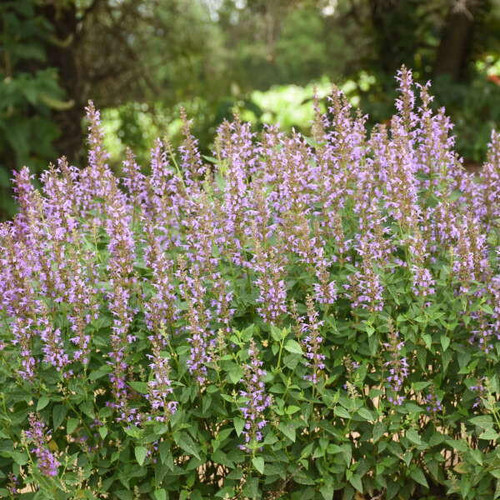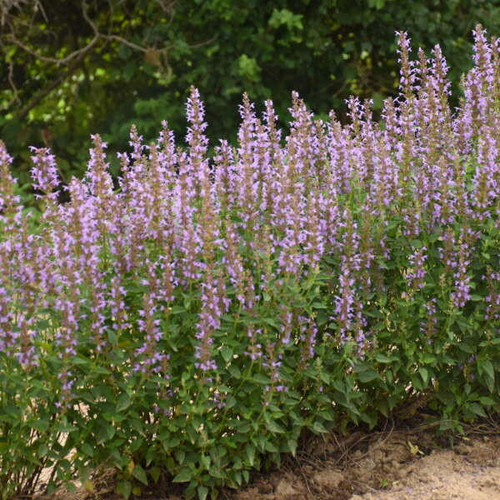Product Description
Agastache 'Guava Lava' PPAF (30)ct Flat
Common Name: Anise Hyssop, Hummingbird Mint
A brightly colored North American native hybrid and favorite of pollinators. 'Guava Lava' begins bloom in the heat of the summer and continues for many weeks. Coral orange flowers are held on equally colorful mauve pink calyxes. Even after the flower has finished, the calyxes remain attractive. Varieties bred here at Walters Gardens have proven to be notably hardy, particularly when sited in loose soils with good drainage.
Agastache are well-adapted to thrive in dry soils and is right at home in rock gardens and xeric container plantings where it will attract hummingbirds, butterflies, and honeybees. This is one of the easiest perennials to grow.
This is a great plant for hot, dry, sunny climates. Well-drained soil is a must, especially in the winter. This plant will not tolerate heavy clay soil but grows well in average to light soil with low to medium moisture levels. In the sandy soil of our zone 5b trial garden, this variety has overwintered with flying colors for the past two years. Even so, it's officially listed as a zone 6 perennial so some winter protection might be required in your zone. No serious pest or disease problems have been reported with this plant.
Height: 20-22 Inches
Spread: 22-26 Inches
Hardiness Zones: 5,6,7,8,9
Flower Color: Gold/Orange Shades
Foliage Color: Green shades
Full Sun (> 6 hrs. Direct Sun)
Low to Average Water Needs
Average to Fertile Soil Quality
Bloomtime: Midsummer - Late Summer, Long Blooming
Attracts Butterflies and Hummingbirds
Bee Friendly
Deer Resistant
Seasonal Interest: Dried Seed Heads
Growth Rate: Medium
Border Plant, Container, Cut Flower, Cut Foliage, Dried Flower, Drought Tolerant, Easy To Grow, Fragrant Flowers, Fragrant Foliage, Mass Planting, Native to North America
Agastache 'Guava Lava' is a hybrid variety of hummingbird mint (also known as anise hyssop) that is prized for its long blooming season and ability to attract pollinators. This variety was developed by Walters Gardens and is part of a collection of pollinator-friendly plants. It is a North American native that has proven to be hardy in USDA zones 5-9 and is deer and rabbit resistant. To compile this information, we explored a variety of online resources, including plant databases, gardening websites, and online retailers.
Appearance Agastache 'Guava Lava' has a dense, well-rounded habit. It typically grows to be 20-22 inches tall and 22-26 inches wide. The foliage is a grayish-green color and has an aromatic, herbal scent. The leaves are also edible. The flowers are a vibrant coral-orange color and are held on equally colorful mauve-pink calyxes. One of the most unique features of this plant is that even after the flowers fade, the calyxes remain attractive and provide visual interest in the garden. The flowers are also edible.
Care Requirements Agastache 'Guava Lava' is a low-maintenance plant that is easy to grow. It prefers full sun and well-drained soil. If your soil is heavy clay, you can amend it with gravel to improve drainage. It is drought tolerant once established, but regular watering is recommended during dry spells. It is not a heavy feeder and does not require a lot of fertilizer. To promote strong stems, avoid overwatering and fertilize only once a year or two in late fall to late winter. Deadheading the faded flowers will prevent seeding and encourage more blooms. In colder regions (zones 5-6), some winter protection might be required.
Uses Agastache 'Guava Lava' is a versatile plant that can be used in a variety of ways in the landscape. It is a great choice for flower gardens, borders, and containers. It can also be used in herb gardens, as the leaves can be used to make tea. The flowers are attractive to pollinators, such as bees, butterflies, and hummingbirds, making it a good choice for pollinator gardens. As it is drought tolerant, it is also well-suited for xeriscaping. The long-lasting blooms are excellent for cut flower arrangements, and the dried seed heads can be used in dried arrangements as well.
Companion Plants Agastache 'Guava Lava' can be planted with a variety of other plants. Some good companion plants include:
- Echinacea (Coneflower)
- Rudbeckia (Black-eyed Susan)
- Monarda (Bee Balm)
- Lavender
- Calamagrostis 'Hello Spring!'
- Echinacea 'Rainbow Sherbet'
- Festuca 'Blue Whiskers'
- Hemerocallis 'Sound of My Heart'
- Leucanthemum 'Banana Cream II'
- Veronica 'Ever After'
Agastache 'Guava Lava' is a beautiful and versatile plant that would make a great addition to any garden. It is a low-maintenance plant that thrives in a variety of conditions. It is also deer and rabbit resistant, making it a good choice for gardens that are prone to these pests. With its long blooming season, vibrant colors, and ability to attract pollinators, Agastache 'Guava Lava' is sure to be a favorite in your garden for years to come. Consider adding this stunning and easy-to-care-for plant to your garden today!
Thirty (30) plants per flat (or tray). Approximate Plug Measurements: 3 inches deep x 2 inches wide.
Other Details
The most important part of the plant is its root system. Healthy roots are the foundation of a healthy, vibrant plant. The type of plug container used is based on the specific needs of the plants. Perennials offered as bare root traditionally perform better when planted as bare root.Planted in a specialized mix, potted plants have well established root systems. Top growth stage will vary depending on the current life cycle and time of year when shipped. In Winter and early Spring dormant plants may be shipped. Dormant plants may be planted right away, even before the last frost date.
Most bare root varieties are field grown for at least one season, though Hemerocallis and Hosta are grown for two seasons. The bulk of the soil is removed during the harvesting process and the tops of most varieties are trimmed back to the crown. They are graded, packed in shredded aspen or sphagnum moss and stored in freezers until ready to be shipped.
See our Container Sizes and Bare Root Perennials pages for more information.
Plant information and care is provided in the Overview section, Plant Genus Page and general information is provided in the Planting Care & Guides. Additional questions can be asked on each Plant page.
Plant Spacing: Using the maximum mature spread or width of a plant to guide spacing, ensures space to grow to full size. To fill an area sooner, plant them closer together. Just remember, future thinning or transplanting may be needed.
Water: Keep a close eye on newly planted perennials, especially throughout the first growing year. Most early plant loss is due to too much or too little water!










